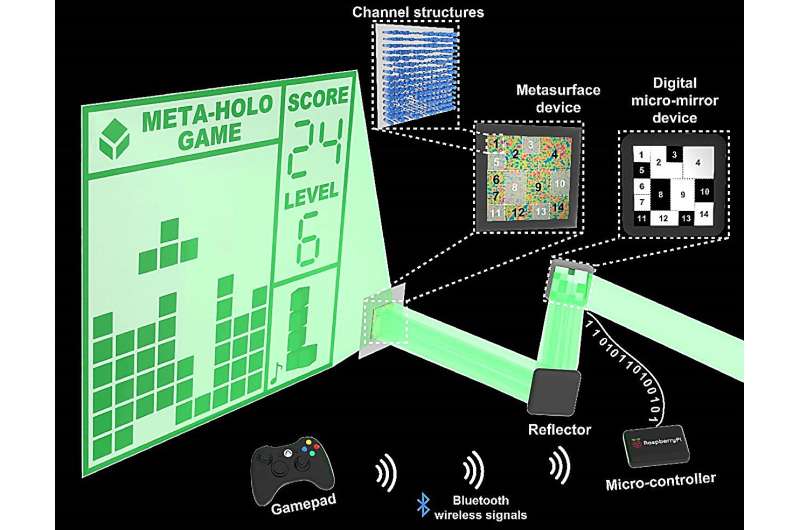This article has been reviewed according to Science X's editorial process and policies. Editors have highlighted the following attributes while ensuring the content's credibility:
fact-checked
proofread
Dynamic interactive bitwise meta-holography with ultra-high computational and display frame rates

Computer-generated holography (CGH) represents a cutting-edge technology that employs computer algorithms to dynamically reconstruct virtual objects. This technology has found extensive applications across diverse fields such as three-dimensional display, optical information storage and processing, entertainment, and encryption.
Despite the broad application spectrum of CGH, contemporary techniques predominantly rely on projection devices like spatial light modulators (SLMs) and digital micromirror devices (DMDs). These devices inherently face limitations in display capabilities, often resulting in narrow field-of-view and multilevel diffraction in projected images.
In recent developments, metasurfaces composed of an array of subwavelength nanostructures have demonstrated exceptional capabilities in modulating electromagnetic waves. By introducing abrupt changes to fundamental wave properties like amplitude and phase through nanostructuring at subwavelength scales, metasurfaces enable modulation effects that are challenging to achieve with traditional devices.
Advances in metasurface-based holography have led to significant achievements such as large viewing angles, achromatic imaging, full-color displays, increased information capacity, and multidimensional multiplexing, making them potent tools for dynamic holographic displays.
Nonetheless, dynamic metasurface holography, still faces great challenges in realizing real-time, highly fluid dynamic display effects required for advanced displays such as advanced human-computer interaction. The key to fluid metasurface holographic displays lies in achieving high computational and display frame rates. Computational frame rate refers to the speed of data calculation, processing, and preparation for display, ensuring the system can compute the required content in real time.
Most current holographic display solutions depend heavily on performing rapid Fourier transforms (FFTs) multiple times, usually requiring dedicated computational units like graphics processing units (GPUs) to meet the demands for high-refresh rates, making computational power and energy consumption critical bottlenecks for widespread application.
On the other hand, the display frame rate, the speed at which display devices refresh and present new content, is crucial for the smoothness of visual content. At present, most dynamic holographic display strategies based on metasurfaces struggle to achieve high display frame rates, which hampers their ability to deliver a fluid visual experience.
Addressing these challenges, a team led by Professor Xiong Wei and Associate Professor Gao Hui from the Wuhan National Laboratory for Optoelectronics at Huazhong University of Science and Technology has introduced a dynamic interactive bitwise metasurface holography (Bit-MH) technique with high computational and display frame rates. They have constructed the world's first practical interactive metasurface holographic display system.
In their study, published in Opto-Electronic Advances, the team segmented the display functionality of metasurfaces into distinct spatial regions or channels, with each capable of projecting a reconstructed sub-holographic pattern. Utilizing optical addressing for spatial channel multiplexing, they mapped the on/off states of all channels to a set of bit values, thus transforming the dynamic updating process of holography into the manipulation of these bit values to control the corresponding channels.
This approach significantly enhances computational efficiency by using mapped bitwise operations instead of relying on frequent FFT calculations required by traditional dynamic holography updates, resulting in efficient dynamic refreshing.
The researchers performed benchmark tests of the core algorithm for bitwise dynamic holography on a low-power Raspberry Pi computing platform, revealing that the maximum computational frame rate of the bitwise dynamic holography approach can reach up to 800 kHz. Additionally, by employing high-speed DMD optical addressing devices, they achieved a maximum display frame rate of 23 kHz.
To demonstrate the concept, the research team built an interactive holographic gaming system for playing Tetris within the visible light spectrum. The system's core components include a spatially segmented metasurface device, DMD, Raspberry Pi controller, gaming controller, and necessary optical components.
The proposed design for bitwise dynamic holography allows for efficient updating of holographic images and real-time interaction with external input devices. This efficient and programmable Bit-MH method is expected to pave the way for future smooth and efficient metasurface holographic display systems.
More information: Yuncheng Liu et al, Dynamic interactive bitwise meta-holography with ultra-high computational and display frame rates, Opto-Electronic Advances (2023). DOI: 10.29026/oea.2024.230108
Provided by Compuscript Ltd





















